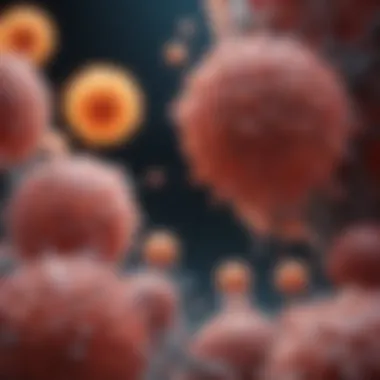Eosinophils and Cancer: Understanding Their Role


Intro
The topic of eosinophils in relation to cancer is an increasingly relevant field of study. Eosinophils are a type of white blood cell that plays a crucial role in immune responses, particularly in combating infections and mediating allergic reactions. However, their function in cancer development and progression presents a complex narrative that warrants careful examination. This exploration moves beyond a surface-level understanding to uncover how these immune cells may influence tumor dynamics and patient outcomes.
Research Overview
Summary of Key Findings
Research indicates that eosinophils can have both pro-tumor and anti-tumor effects depending on the type of cancer and the microenvironment of the tumor. Some studies suggest that increased eosinophil counts correlate with better prognosis in certain cancers, while in others, they may support tumor growth and metastasis.
Research Objectives and Hypotheses
The aim of this research is to clarify the dual role of eosinophils in cancer. Specifically, we seek to:
- Identify the types of cancers where eosinophils are prominently involved.
- Analyze the mechanisms that mediate their effects on tumors.
- Examine potential therapeutic implications of eosinophil manipulation.
Methodology
Study Design and Approach
The studies analyzed in this article employed a range of methodologies, including retrospective analyses of patient data, experimental animal models, and in vitro assays. By combining these approaches, researchers can triangulate findings and build a comprehensive view of eosinophil dynamics in cancer.
Data Collection Techniques
Data was collected from multiple sources:
- Clinical Studies: Patient records were reviewed for eosinophil counts and associated outcomes.
- Laboratory Experiments: Models were used to observe eosinophil behavior in a controlled environment.
- Immunohistochemistry: Tissue samples from cancer patients were analyzed to detect eosinophil infiltration.
Eosinophils may serve as both allies and adversaries in the battle against cancer, making their role complex and multifaceted.
This introduces the complexities behind how eosinophils interact with various cancers. As future research unfolds, a clearer picture may emerge, opening doors for innovative treatments and diagnostic tools.
Preamble to Eosinophils
Eosinophils are a type of white blood cell, playing an essential role in the immune response. Their significance in various biological processes, especially in the context of cancer, cannot be overstated. This section aims to provide a solid foundation for understanding how eosinophils operate within the immune system and their potential implications for cancer biology.
Definition and Function
Eosinophils are granular leukocytes, easily identified by their distinctive red-orange granules when stained. They originate from pluripotent stem cells in the bone marrow and typically comprise about 1-4% of the total white blood cell count in healthy adults. Their primary functions include combating parasitic infections and mediating allergic reactions.
In addition to these roles, eosinophils produce a variety of cytokines, enzymes, and toxic proteins, including major basic protein and eosinophil peroxidase, which enable them to interact profoundly with other immune cells. This active participation in both innate and adaptive immune responses makes eosinophils crucial players in modulating inflammation and tissue homeostasis.
Eosinophils in Immune Response
In the context of immune defense, eosinophils are particularly known for their involvement in allergic disorders and responses to parasitic infections. Upon activation, these cells migrate to sites of inflammation, where they can become translocated by various signaling molecules such as chemokines. Eosinophils release pro-inflammatory mediators that help recruit additional immune cells, thereby amplifying the immune response.
Moreover, eosinophils have a critical role in regulating immune responses related to tumorigenesis. Emerging research indicates that these cells can influence tumor microenvironments, either by promoting or inhibiting tumor growth. This dual behavior underscores the complexity of eosinophils' functions and emphasizes the need for further exploration into their roles in cancer biology.
Understanding eosinophils extends beyond traditional immune functions. Their implications in cancer progression and treatment are an evolving area of research, making them a focal point for potential therapeutic strategies.


As we delve deeper into eosinophil functions, the connections between these cells and cancer will become clearer. This understanding can lead to new insights into cancer treatment protocols and patient management, highlighting the importance of eosinophils in oncology.
Eosinophils in Cancer Biology
Eosinophils are a unique subset of white blood cells, traditionally associated with allergy and parasitic infections. However, recent research has unveiled their significant involvement in cancer biology. Understanding eosinophils in this context is crucial for various reasons. They can either promote or inhibit tumor growth, depending on the tumor type and microenvironment. This dual role makes them interesting subjects for cancer studies. Moreover, their presence in tumors and blood can have prognostic implications, potentially influencing treatment decisions.
Role of Eosinophils in Tumor Microenvironment
Eosinophils play a complex and dynamic role in the tumor microenvironment. Their interaction with cancer cells and other immune cells shapes the local immunological landscape. In some cases, eosinophils may enhance tumor growth through the release of growth factors and cytokines. This activation of nearby cells creates a pro-tumor environment, which can facilitate cancer progression.
Conversely, eosinophils can exert anti-tumor effects. They can release cytotoxic granules that target tumor cells, promoting cell death. Their chemotactic properties help recruit other immune cells, such as T cells and macrophages, to the tumor site. This recruitment can augment the immune response against cancer cells, highlighting a potential for eosinophil-centric therapies.
Research indicates that the efficacy of eosinophil functions hinges on the types and amounts of cytokines present in the tumor microenvironment. Eosinophil numbers and activity might vary significantly across different cancers, depending on underlying mechanisms and local factors.
Cytokine Release and Tumor Promotion
Eosinophils are significant producers of cytokines, which are critical to their role in cancer. Upon activation, they can secrete a variety of cytokines, including interleukin-5, interleukin-13, and tumor necrosis factor-alpha. These cytokines influence immune responses and can alter tumor behavior.
For instance, interleukin-5 is particularly important for eosinophil survival and proliferation. In a cancer context, high levels of this cytokine can contribute to eosinophilia, an increased eosinophil count, which has been noted in some tumor types. Elevated eosinophil counts may correlate with tumor progression and poorer prognoses in certain cancers.
Additionally, the release of other inflammatory mediators from eosinophils can directly promote tumor growth. This relationship raises essential questions about the timing and context of eosinophil activity in cancer therapy. Eosinophils should be considered not only as contributors to inflammation but also as potential targets for novel therapeutic approaches. Their dual capability—to aid in tumor destruction or, conversely, to promote tumor growth—necessitates a deeper exploration into their biological functions.
"Eosinophils hold a dual role in cancer biology, acting as potential allies in tumor destruction while also having the capacity to support tumor growth."
In summary, eosinophils serve as vital components in the tumor microenvironment, influenced by cytokine release and other factors. Their functions and interactions in cancer biology are complex, yet understanding them can lead to novel diagnostic and therapeutic methods in oncology.
Eosinophil Counts Across Different Cancer Types
Eosinophil counts play a significant role in the study of cancer. Understanding how these immune cells manifest across different cancer types offers insights into tumor biology and potential therapeutic strategies. Eosinophilia, or an increased number of eosinophils, can indicate various biological processes occurring within tumors and the broader immune response. The examination of eosinophil counts may also assist in prognostic assessments and treatment planning.
Eosinophilia in Hematological Malignancies
Hematological malignancies, including leukemia and lymphoma, often present with pronounced eosinophilia. This condition may result from the direct influence of malignant cells on the bone marrow. For instance, in cases of acute myeloid leukemia, eosinophils may surge due to increased cytokine production, fostering an environment conducive to tumor growth. Such eosinophilia typically correlates with a better prognosis due to these immune cells' potential antitumor effects. However, this can vary significantly between subtypes of leukemia and lymphoma, emphasizing the importance of analyzing eosinophil levels in a clinical context.
Solid Tumors and Eosinophil Presence
The presence of eosinophils in solid tumors provides a mixed picture. Their role can vary widely among different types of cancers and might influence tumor progression.
Breast Cancer
In breast cancer, eosinophils have been shown to impact tumor immunity. They often infiltrate the tumor microenvironment, which suggests an active role in modulating antitumor responses. Increased eosinophil counts may correlate with favorable outcomes, indicating that these cells could contribute to controlling tumor growth. However, their presence needs further examination to fully understand their dual roles as potential helpers or hinderers in tumor progression.
Lung Cancer
Lung cancer is another area where eosinophil counts vary significantly. Studies indicate that those with eosinophilia may see different outcomes depending on the histological type. For non-small cell lung cancer, eosinophils might be associated with a better immune response against the tumor. Conversely, in small cell lung cancer, high eosinophil levels could signal a more aggressive tumor behavior. This dichotomy presents challenges in interpreting eosinophil involvement and underscores the need for careful research.
Colorectal Cancer
Colorectal cancer displays a complex relationship with eosinophilia. Some studies suggest that high levels of eosinophils may correlate with a better response to treatment and a more favorable prognosis. This phenomenon is potentially linked to eosinophils' roles in promoting an inflammatory environment conducive to tumor elimination. Nevertheless, their exact contributions and mechanisms in colorectal cancer remain areas for further in-depth exploration.


"The increasing recognition of eosinophils in cancer biology marks a pivotal shift in how we approach cancer research and therapy. Their diverse roles must be understood in the context of each cancer type to harness their full potential in future treatments."
In summary, the relationship between eosinophils and various cancer types is multifaceted. Eosinophil counts serve as a critical indicator, suggesting both prognostic value and potential therapeutic relevance. Future studies will be pivotal in deciphering how these immune cells can be leveraged in the fight against cancer.
Mechanisms of Eosinophil Action in Cancer
The study of eosinophils in relation to cancer provides crucial insights into how these immune cells function within the cancer landscape. Understanding the mechanisms of eosinophil action can enhance our knowledge regarding tumor behavior and the potential outcomes for patients. This section delves into the specifics of how eosinophils interact with tumor cells, and the implications of inflammatory mediators.
Direct Tumor Cell Interaction
Eosinophils can interact directly with tumor cells in several ways. Their primary actions often involve the release of cytotoxic granules containing proteins that can induce apoptosis, or programmed cell death, in cancerous cells. One of the key components in this process is major basic protein (MBP). This protein can damage the membranes of cancer cells, providing a mechanism through which eosinophils exert their influence on tumor growth and survival. Studies have shown that in certain cancers, a high presence of eosinophils correlates with a better prognosis, suggesting that their cytotoxic effects may limit tumor progression.
Moreover, eosinophils can also influence the immune response surrounding tumors. By secreting various cytokines, they can modulate the activity of other immune cells. For instance, eosinophil-derived interleukin-5 can amplify eosinophil production and recruitment to the tumor site, thus enhancing their potential antitumor effects. This interaction establishes a feedback loop where eosinophils not only act against tumors but also play a role in shaping the immune microenvironment.
Inflammatory Mediators and Tumor Growth
Eosinophils are significant sources of inflammatory mediators that can have dual effects on tumor growth. On one hand, these mediators can effectively inhibit tumor progression; on the other, they may inadvertently promote tumor growth under certain conditions. For example, eosinophils release cytokines such as transforming growth factor beta (TGF-β). While this factor can help regulate immune responses, it can also support tumor cell proliferation in a different context.
The complexity of the eosinophil-cancer relationship lies in the nature of the inflammatory environment. In certain tumors, the release of eosinophils can be linked to increasingly aggressive tumor behavior.
- Elevated levels of eosinophilic inflammation have been observed in cancers like lung and colorectal cancer, where they might contribute to metastasis, depending on tumor-associated factors.
- Research indicates that eosinophils can also produce vascular endothelial growth factor (VEGF), which is crucial for angiogenesis – the formation of new blood vessels that tumors need to grow.
Eosinophils can promote both antitumor and protumor mechanisms, making their role in cancer highly complex.
Clinical Significance of Eosinophils in Oncology
Eosinophils are increasingly recognized for their significance in oncology. Their presence in tumors can provide valuable information about patient prognosis and potential treatment strategies. Understanding eosinophils can enhance the entire cancer management process. Their role is multifaceted, influencing tumor behavior and patient outcomes.
Eosinophil Counts as Prognostic Markers
Eosinophil counts in the blood can serve as important prognostic markers in various cancers. For instance, elevated levels of eosinophils, known as eosinophilia, have been associated with better survival rates in certain hematological cancers. This correlation can be crucial for oncologists when tailoring treatment plans.
Several studies have suggested that high eosinophil counts might correlate inversely with tumor burden. They can indicate a robust immune response against cancer cells, which is often desired for effective treatment outcomes.
However, the context matters.
- In solid tumors, the implications of eosinophil counts can vary greatly.
- Some solid tumors may show eosinophilia as a sign of poor prognosis, suggesting a more complex interaction where eosinophils may also facilitate tumor growth in some environments.
These paradoxes necessitate further research to clarify the prognostic value of eosinophils across different cancer types.
Potential Therapeutic Implications
The therapeutic potential of eosinophils is still an evolving area of research. Eosinophils might be harnessed for therapy, perhaps through eosinophil-targeted treatments. Understanding their biology could lead to innovative strategies in managing cancer.
For example, manipulating eosinophil activity might enhance an anti-tumor response. Considerations include:
- Immunotherapy: Eosinophils could play a role in enhancing the efficacy of immunotherapeutic approaches. Their unique ability to release cytokines can modulate the tumor microenvironment, potentially improving treatment outcomes.
- Cytokine Therapies: Targeting specific cytokines related to eosinophil activation may present new avenues for treatment, offering better control over tumor growth.
Current research efforts aim to unravel these therapeutic pathways, emphasizing the need for comprehensive clinical trials.


Research Advances in Eosinophil Studies
The investigation of eosinophils in the context of cancer has witnessed significant strides in recent years. This section highlights the importance of these advances, particularly in understanding how eosinophils interact with tumors and their possible implications for therapeutic strategies. Recognizing the evolving landscape of eosinophil research is crucial for both practitioners and researchers in oncology, as it assists in framing future inquiries and enriches existing knowledge about immune responses in cancer.
Emerging Techniques in Eosinophil Research
Recent developments in molecular biology and immunology have ushered in novel techniques that enhance our ability to study eosinophils. For instance, single-cell RNA sequencing allows for the analysis of gene expression profiles on a cellular level. This is essential for identifying distinct eosinophil subtypes and understanding their specific roles within the tumor microenvironment.
Additionally, advanced imaging techniques, like intravital microscopy, provide real-time visualization of eosinophil behavior in living tissues. This is particularly valuable in studying how these cells migrate towards tumors and interact with other immune cells. Techniques such as flow cytometry further allow for the detailed characterization of eosinophil populations, emphasizing differences in activation status or cytokine production.
"Understanding the cellular interactions facilitated by eosinophils in tumors paves the way for more targeted therapeutic approaches."
These techniques are not merely enhancements to study methodology; they expand the horizon of possibilities for personalized medicine. By better identifying which eosinophil populations are present in specific cancers, clinicians might tailor interventions that harness or modulate these cells effectively.
Impacts of Recent Findings
Recent findings in eosinophil research have significant implications for cancer biology and therapy. Studies indicate that eosinophil infiltration correlates with better prognosis in certain cancers, such as colorectal cancer. This suggests a potential protective role for eosinophils in the immune surveillance of tumor growth. However, in other contexts, eosinophils may facilitate tumor progression, highlighting a dual role in cancer dynamics.
The implications extend to therapeutic avenues as well. Understanding eosinophil behavior may lead to novel immune-based therapies. For example, eosinophil-targeted treatments could modulate their activity in order to enhance anti-tumor responses or diminish tumor-promoting effects. Thus, the recent findings inspire a reevaluation of existing therapeutic frameworks and challenge traditional views on eosinophils as solely pro-inflammatory agents.
Future Directions in Eosinophil Cancer Research
Understanding the role of eosinophils in cancer progresses along a promising path. Future research directions must build on current findings to unravel more complex interactions between eosinophils and tumor cells. One crucial focus area involves identifying specific eosinophil functions associated with various cancer types. This is essential for establishing the diverse roles eosinophils may play, from potentially promoting tumor growth to participating in immune responses against tumors. Furthermore, a deeper understanding of these functions will enhance diagnostic precision and pave the way for targeted therapeutic strategies.
Identifying Eosinophil Functions
In order to tap into the potential of eosinophils in cancer treatment, researchers need to identify their various functions during tumor progression. Eosinophils are often reported at the tumor microenvironment, but their specific roles are still not fully understood. Some studies suggest that they may directly interact with tumor cells, influencing their growth and migration. Finding out how eosinophils communicate with cancer cells is critical.
In addition, eosinophils release a range of cytokines and other mediators, which can either facilitate tumor progression or hindering it. This duality in their functions necessitates comprehensive studies aimed at clarifying which pathways are activated in different cancer settings. Insights into these mechanisms could lead to leveraging eosinophils as immunotherapeutic agents.
Integration into Cancer Treatment Paradigms
Incorporating eosinophil research into existing cancer treatment paradigms holds great promise. Once their roles and mechanisms are better understood, it might be possible to use eosinophils as biomarkers for patient stratification. This means that eosinophil counts could help predict responses to therapies in certain cancers. Additionally, modulating eosinophil activity could complement conventional therapies, improving overall patient outcomes.
For example, increasing eosinophil activity in specific cancers could enhance immune responses against tumors. Conversely, in cases where eosinophils may support tumor growth, suppressing their actions could be advantageous. The integration of these strategies necessitates careful consideration of eosinophil behavior in the context of each unique tumor microenvironment.
"Understanding eosinophils' roles can illuminate novel therapeutic avenues and enhance patient care strategies."
Future investigations can help clarify these ideas while prompting the design of clinical trials that examine eosinophil-targeted approaches. Further inquiry is required to refine the pharmacological manipulation of these immune cells. Thus, the exploration of eosinophils in cancer research is a vital frontier that merits continued attention.
End
The conclusion serves a critical purpose in summarizing the complex interactions between eosinophils and cancer. It ties together the essential findings presented throughout the article, providing clarity on how eosinophils may influence tumor dynamics. This synthesis is vital for anyone invested in cancer research, as it highlights both the potential benefits and considerations necessary for future explorations.
Summary of Eosinophils' Role in Cancer
Eosinophils have emerged as significant players in the cancer landscape. Their presence can differ vastly across various cancer types, and this variability raises important questions about their functions. In some contexts, eosinophils could exhibit anti-tumor effects, while in others, they may contribute to tumor progression through cytokine release and interactions with the tumor microenvironment. Understanding these dual roles is essential. They not only potentially serve as biomarkers for prognosis but may also open new avenues for therapeutic strategies aimed at modulating eosinophil activity to improve patient outcomes.
Call for Continued Research
There remains a considerable gap in the literature regarding the precise mechanisms that eosinophils employ in cancer contexts. Engaging in deeper research is crucial. Future studies must focus on several pivotal areas:
- Elucidating specific functions: What are the distinct roles of eosinophils in various tumor microenvironments?
- Examining therapeutic links: How might eosinophils be targeted in treatment strategies, or how can their action be harnessed for therapeutic gain?
- Exploring the implications of eosinophil counts: What do varying eosinophil levels indicate regarding tumor biology and patient prognosis?
Continued investigation into eosinophils and their multi-faceted roles in cancer can drive advancements in cancer treatment and patient care.
In summary, focusing on eosinophils could lead to significant breakthroughs in our understanding of cancer and its treatment. The complexities surrounding eosinophil involvement in cancer warrant thorough exploration and could potentially reshape how oncologists approach diagnosis and therapy.















